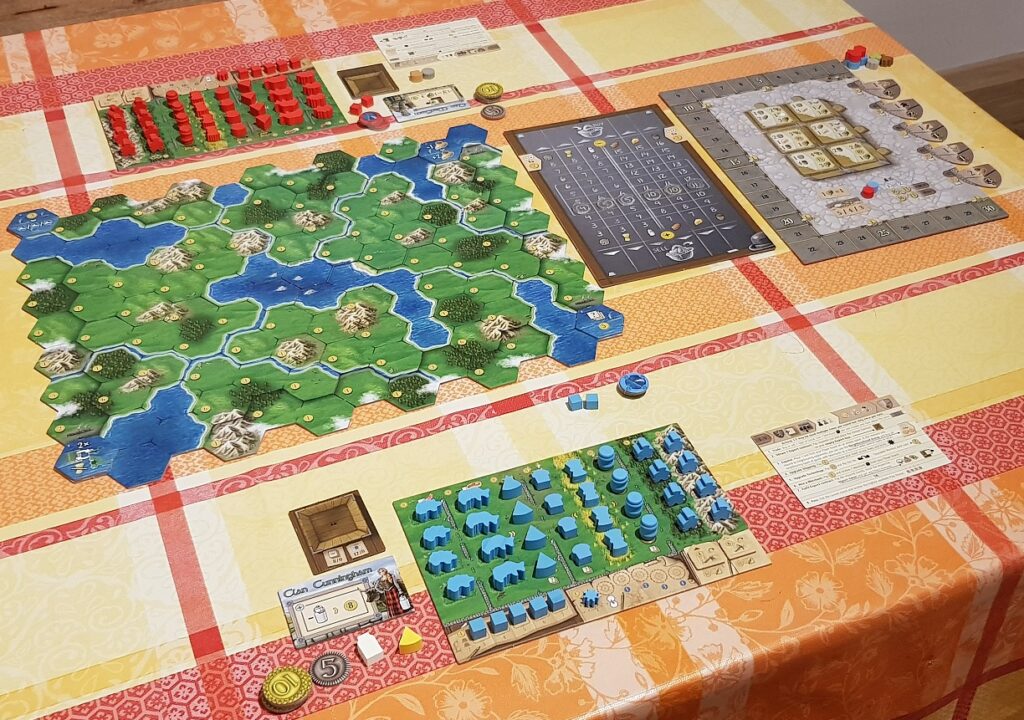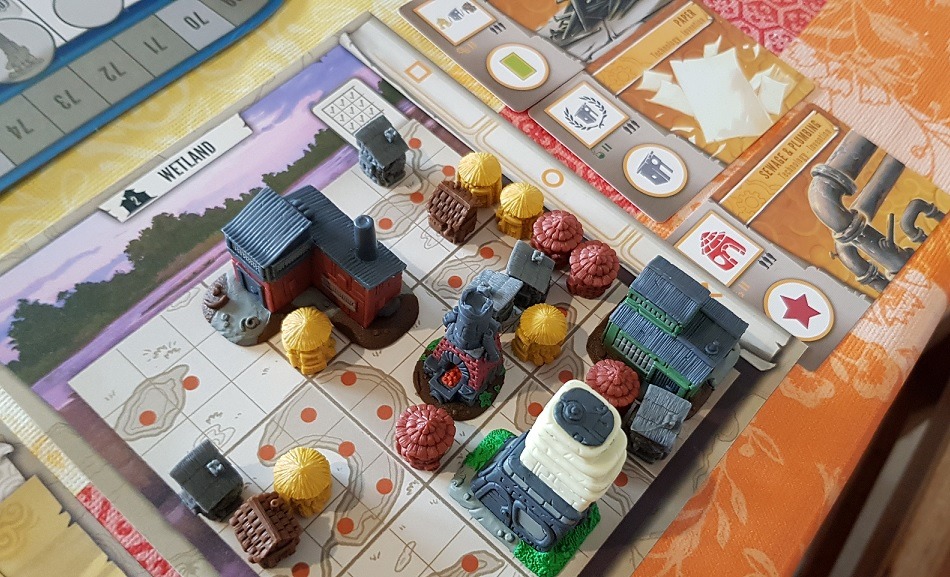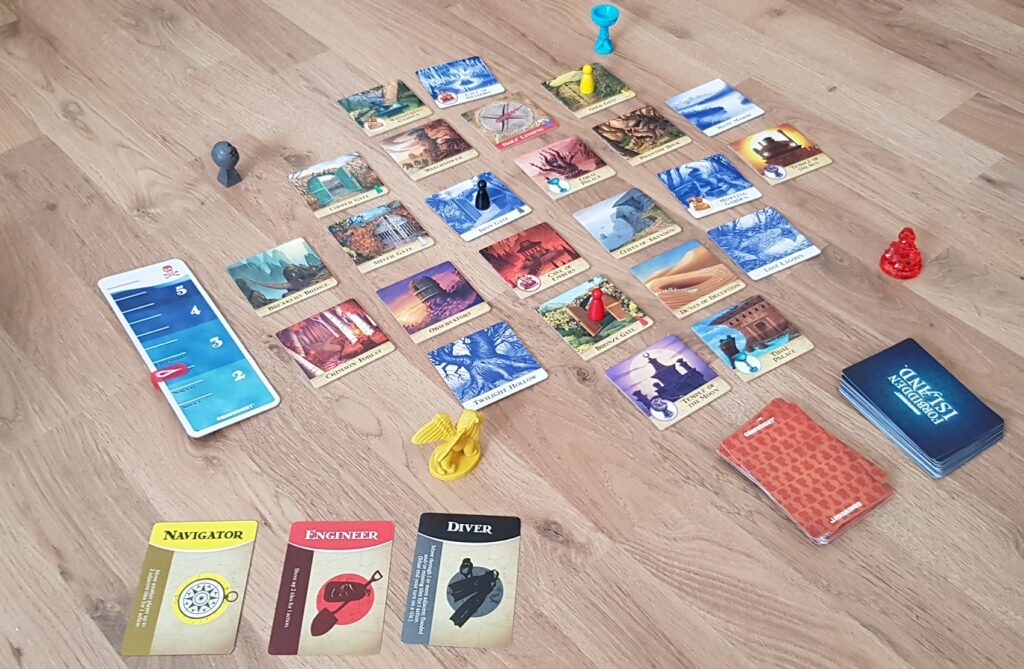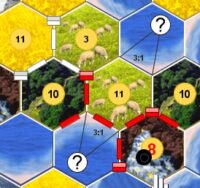Eurogame is a term often heard in board games terminology. It is also often used incorrectly or people don’t even know what it means and use it because someone else speaks that way and it sounds cool. We’re going to have a look at what is a eurogame, what characteristics are typical for a eurogame, and look at some examples.

History and Origins of Eurogames
Eurogames are also often called German-style board games, because, you guessed it, they originate from Germany. Legend implies that after the second world war, which in Germany was a time of rebuilding the country and economic development, the board games also took on a more peaceful note.
Agriculture, building, and trading were more welcomed over fighting and destroying. It is the exact opposite of an American-type board game (another vaguely used term), which focuses on conflict, elimination, and (one) winner-takes-all play style.
The genre began picking up the pace in the 60s, 70s, and 80s, but it was in 1995 when it really took off: 1995 marks the publishment of Settlers of Catan. Even though it wasn’t the first eurogame in Germany or the first that made it out abroad, it was the first that became a mainstream hit, scored some big sales numbers, and gained popularity among players all over the world.

That opened up the market for other popular games like Tigris and Euphrates (1997) Carcassonne (2000), Puerto Rico (2002), Power Grid (2004), Ticket to Ride (2004), and many others. These days the genre has really boomed and more eurogames are published every year than anyone can even count, let alone play or review.
What is a Eurogame?
One thing the eurogame is not: it’s not a geographical term. It was in the beginning, but in our era of globalization, such things do not exist anymore.
It’s not easy to define the term exactly, because eurogames often have very different game mechanics and themes from one to another. Even the “official” Wikipedia definition admits, that it’s an “imprecise label”.
But eurogames do have a lot of common characteristics, and I believe it is by these characteristics, that they are best described.
Characteristics of Eurogames
1. Designer games
Eurogames started the trend of exposing and branding the designer. (Although now everybody does it.) Some of them (you probably heard of Reiner Knizia, Uwe Rosenberg, Klaus Teuber, Jamey Stegmaier, and Klaus-Jürgen Wrede among others) became quite famous and used their following to launch other games also designed by them.
2. Reliance on luck is minimal
Eurogames rely on skill rather than luck. Although there may still be some random factors involved (drawing of cards or tiles, setup of the board, or victory conditions), these factors do not affect the outcome of the game, but diversify the gameplay and increase replay value.
If there is a random factor, it usually happens before the player acts, so he has enough time to think and react. For example – in Carcassonne player draws a random terrain tile and then decides where to place it. In Catan, dice throw decides about resource distribution, but after that, it’s player’s choice of how to spend them.
That’s in contrast with wargames, where you first declare an attack and only then roll dice to see the outcome (i.e Root).

3. The theme is very pronounced but not necessarily gameplay-related
The theme in eurogames is often well-thought-out and executed to the detail (artistic style, quality wooden tokens, and miniatures), but they are not essentially connected to the gameplay, but act as a tool to name abstract game elements (tiles, resources, meeples).
It is not unusual for games to be given a re-branding as a completely different theme (for example Catan: Star Trek uses outposts and Starbases as settlements and Dilithium, Tritanium, Oxygen, and Food as resources), but the gameplay mechanics stay the same.
Of course, a pasted-on theme is not going to cut it for the players in the long run. Therefore, most games these days try to intertwine their theme with game mechanics, which provides deeper immersion, more intuitive gameplay, and as a result, higher long-term value. A good example would be Ark Nova.
4. Players do not get eliminated
Contrary to “American” type board games, in eurogames, all players remain in the game to the very end. The winner is determined by victory points and is often unknown until the very end when the points are counted. Late twists, like hidden victory points, often turn the tables and one can never be sure in victory until the very end. Often, more paths to victory points are available.
Games can’t drag on forever but are limited by either victory points or depletion of resources, turns, or tiles. Therefore, they are easier to plan an evening around, because you always know how long it takes to finish a game. Most eurogames try to hit the “movie-length” sweet spot of around 1-2 hours per game.

5. Game mechanics
Game mechanics follow the rule “easy to learn, but hard to master”. Single-player was rarer to find until recently (and is now more and more popular), and games are designed around the 2-6 player limit, but 3-4 is most commonly the sweet spot. Combining this with their playtime and no-player-elimination, eurogames are ideal family games or gateway games (board games with game mechanics and themes that appeal to a wide audience – making them great for novice players).
Players do not interact directly on board (combat is almost unheard-of in eurogames), but rather indirectly: competing for victory points, resources, tiles, and trading. Mechanics used are common, but often implemented in fresh and original variations, including:
- engine-building (upgrading your resource or points-gathering ability),
- controlling areas on the board (by placing tokens or meeples),
- deck-building,
- trading and auctioning (with the bank or other players) and
- collecting resources (and buying or upgrading with them).

Final Thoughts on the Term Eurogames
As eurogames have made it big all around the globe, so have their distinct characteristics blurred and mixed. Board games that are published nowadays, commonly feature many euro and non-euro characteristics (i.e. Scythe is a eurogame, disguised as a wargame), trying to be original and stand out in a very densely populated market.
In a conclusion, a eurogame term today is not something that strictly defines a genre of board games, but rather a term that defines a group of board games of different genres, themes, and game mechanics – which have a common philosophy on how a board game should look, be made and be played.
Read the reviews of games below for perfect examples of the eurogame genre:
Have a question or an opinion? Post it in a comment below!
Vasilij

Sounds like Euro Games might offer a pleasant reprieve from my favorite games at least while playing with the kids who often fight over who is winning and who already lost. I can see where they would have their place in social gatherings like parties and can even be the subject of a budding small talk session. I am just wondering where it is best to find a selection that might improve our collection and be fun for the whole family? Thanks, for a great post.
My post about best games for couples already covers some eurogames like Kingdomino, Carcassonne, Akrotiri and Pandemic. Settlers of Catan is a great starting point, too.
The other thing that I think this article gets dead wrong is citing Monopoly as a typical American style board game. It has a lot more in common with a typical economics simulation Euro than it has in common with games denoted as American style.
The skin on Monopoly is absolutely minimal, as is the art.
The theme of Monopoly is economics simulation. Like many Euro games. it is a completely non-violent. It also involves building things, whereas most American style games are about tearing things down.
It involves a great deal of trading to maximize your set- which is typical for many Euros like Catan or Sidereal Confluence.
Conflict in Monopoly is 100% indirect. Players are encouraged to build their own little empires and hog all the houses to deprive one another of resources, which is very euro gameplay.
I have heard some say that the roll and move element is American, but the truth is, it is outdated no matter what kind of game you’re playing.
The truth is, people want to say that Monopoly is American style because they don’t like it at all. But the fail mode of Euro game is Bad Euro Game, not American Game.
You are partly right. However, there are strong non-euro elements in Monopoly, like player elimination and high reliance on luck with no options to mitigate it.
But, as said “eurogame” is a very vague term that has become redundant in recent years. More and more games combine different game mechanics and concepts. The location of the design/production is also irrelevant in today’s globalized world.
Eurogames are becoming more and more popular within all sorts of different communities around the world which is really exciting for me. Until reading this article, I never realized the true meaning of eurogame. I learned something new today so thanks for that. Keep up the good work and I am looking forward to your next article.
I’m glad the post was helpful to you. Eurogames is a term many people throw around (in context with amerotrash) without knowing what either means.
This has been a great learning experience. That history of Euro games is quite enlightening. I love any game of skill as it keeps the mind busy and stimulated the entire time. I have never played this game before but I feel like I have all it takes to start playing if an opportunity arises. Will give a try on one pf your suggestions, probably the Catan. Thank you for a detailed explanation of the Eurogame. Great article.
You can’t go wrong with Catan. 🙂
You can even play it online on Colonist or AsoBrain.
I still do not understand how people think that the random elements in a Euro do not effect the outcome of the game.
I mean, if no good quests come up to help out your Lord of Waterdeep, or if you get one that’s super beneficial and aligns well at the start of the game, it will effect the game’s outcome. Or if the resource you need is rolled in Catan or not, or the cards you need for that great combo in Mage Knight don’t come up, etc.
Rather, I think that the principle is that luck in a Euro comes before the strategy. Rather than doing risk management strategies and then rolling for success, you first receive the random elements, and then the strategy is in doing what you can with them. Usually, luck is not part of the action resolution step.
The truth is, the games are no more or less strategic than other games, they simply put the strategy and random elements in a different order (which is a big change, don’t get me wrong).
Of course, most games now are hybrids of some sort that don’t fit neatly into any single category.
There will always be an element of luck, where there’s a random factor involved. Even if you’re just drawing a tile or an enemy token. You can (and will) get lucky and unlucky games.
It’s the next step (the strategy step if you will) that’s important and that’s what and to what extent can you manipulate that random element to your benefit.
For example – you attack a hidden enemy in Mage Knight and after revealing, you realize it’s going to be a tough nut to crack. But it’s still up to you to play your cards right and figure out how to deal with it the best way possible.